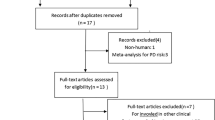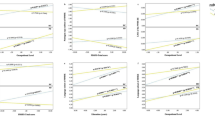Abstract
Parkinson’s disease (PD) patients show a range of cognitive deficits,which may relate to abnormalities in dopaminergic transmission in fronto–striatal circuitry. In this study, we have investigated the impact of brainderived neurotrophic factor (BDNF) val66met polymorphisms on performance of the Tower of London (TOL) test of planning by PD patients. This polymorphism significantly influences BDNF secretion in the CNS, and BDNF is known to influence dopaminergic neurons and cognitive processes. Patients with PD totalling 291 who had undergone detailed motor and cognitive assessments as part of a population–based study of PD were genotyped for the BDNF val66met polymorphism. The impact of this polymorphism on cognitive ability was determined using multivariate analysis to adjust for possible confounding variables. Patients with low rates of BDNF secretion (met alleles) performed significantly better at the TOL task than those with high rates of secretion (val alleles). Furthermore, subgroup analyses revealed that the effect is most apparent in women and among patients with prior dopaminergic exposure. We speculate that BDNF may interact with dopaminergic transmission and dopamine receptor stimulation in the frontostriatal circuitry, with subsequent consequences on cognition in Parkinson’s disease.
Similar content being viewed by others
References
Angelucci F, Mathe AA, Aloe L (2004) Neurotrophic factors and CNS disorders: findings in rodent models of depression and schizophrenia. Prog Brain Res 146:151–165
Berchtold NC, Kesslak JP, Pike CJ, Adlard PA, Cotman CW (2001) Estrogen and exercise interact to regulate brain-derived neurotrophic factor mRNA and protein expression in the hippocampus. Eur J Neurosci 14:1992–2002
Bimonte-Nelson HA, Singleton RS, Nelson ME, Eckman CB, Barber J, Scott TY, Granholm AC (2003) Testosterone, but not nonaromatizable dihydrotestosterone, improves working memory and alters nerve growth factor levels in aged male rats. Exp Neurol 181:301–312
Bimonte HA, Nelson ME, Granholm AC (2003) Age-related deficits as working memory load increases: relationships with growth factors. Neurobiol Aging 24:37–48
Bushnell PJ, Levin ED (1993) Effects of dopaminergic drugs on working and reference memory in rats. Pharmacol Biochem Behav 45:765–776
Egan MF, Kojima M, Callicott JH, Goldberg TE, Kolachana BS, Bertolino A, Zaitsev E, Gold B, Goldman D, Dean M, Lu B, Weinberger DR (2003) The BDNF val66met polymorphism affects activity- dependent secretion of BDNF and human memory and hippocampal function. Cell 112:257–269
Foltynie T, Goldberg TE, Lewis SJ, Blackwell AD, Kolachana B, Weinberger D, Robbins T, Barker RA (2004) Planning ability in Parkinson’s Disease is influenced by the COMT Val158Met polymorphism. Mov Disord 19:885–891
Gibb WR, Lees AJ (1988) The relevance of the Lewy body to the pathogenesis of idiopathic Parkinson’s disease. J Neurol Neurosurg Psychiatry 51:745–752
Glickstein SB, Hof PR, Schmauss C (2002) Mice lacking dopamine D2 and D3 receptors have spatial working memory deficits. J Neurosci 22:5619–5629
Goldman-Rakic PS (1999) The “psychic” neuron of the cerebral cortex. Ann N Y Acad Sci 868:13–26
Green J, McDonald WM, Vitek JL, Evatt M, Freeman A, Haber M, Bakay RA, Triche S, Sirockman B, DeLong MR (2002) Cognitive impairments in advanced PD without dementia. Neurology 59:1320–1324
Guillin O, Diaz J, Carroll P, Griffon N, Schwartz JC, Sokoloff P (2001) BDNF controls dopamine D3 receptor expression and triggers behavioural sensitization. Nature 411:86–89
Guillin O, Griffon N, Bezard E, Leriche L, Diaz J, Gross C, Sokoloff P (2003) Brain-derived neurotrophic factor controls dopamine D3 receptor expression: therapeutic implications in Parkinson’s disease. Eur J Pharmacol 480:89–95
Hakansson A, Melke J, Westberg L, Shahabi HN, Buervenich S, Carmine A, Klingborg K, Grundell MB, Schulhof B, Holmberg B, Ahlberg J, Eriksson E, Sydow O, Olson L, Johnels B, Nissbrandt H (2003) Lack of association between the BDNF Val66Met polymorphism and Parkinson’s disease in a Swedish population. Ann Neurol 53:823
Hall D, Dhilla A, Charalambous A, Gogos JA, Karayiorgou M (2003) Sequence variants of the brain-derived neurotrophic factor (BDNF) gene are strongly associated with obsessivecompulsive disorder. Am J Hum Genet 73:370–376
Hariri AR, Goldberg TE, Mattay VS, Kolachana BS, Callicott JH, Egan MF, Weinberger DR (2003) Brain-derived neurotrophic factor val66met polymorphism affects human memory-related hippocampal activity and predicts memory performance. J Neurosci 23:6690–6694
Hoglinger GU, Sautter J, Meyer M, Spenger C, Seiler RW, Oertel WH, Widmer HR (1998) Rat fetal ventral mesencephalon grown as solid tissue cultures: influence of culture time and BDNF treatment on dopamine neuron survival and function. Brain Res 813:313–322
Hong CJ, Liu HC, Liu TY, Lin CH, Cheng CY, Tsai SJ (2003) Brain-derived neurotrophic factor (BDNF) Val66Met polymorphisms in Parkinson’s disease and age of onset. Neurosci Lett 353:75–77
Hyman C, Hofer M, Barde YA, Juhasz M, Yancopoulos GD, Squinto SP, Lindsay RM (1991) BDNF is a neurotrophic factor for dopaminergic neurons of the substantia nigra. Nature 350:230–232
Hyman C, Juhasz M, Jackson C, Wright P, Ip NY, Lindsay RM (1994) Overlapping and distinct actions of the neurotrophins BDNF, NT-3, and NT-4/5 on cultured dopaminergic and GABAergic neurons of the ventral mesencephalon. J Neurosci 14:335–347
Ivanova T, Kuppers E, Engele J, Beyer C (2001) Estrogen stimulates brain-derived neurotrophic factor expression in embryonic mouse midbrain neurons through a membrane-mediated and calcium-dependent mechanism. J Neurosci Res 66:221–230
Joyce JN, Renish L, Osredkar T, Walro JM, Kucera J, Dluzen DE (2004) Methamphetamine-induced loss of striatal dopamine innervation in BDNF heterozygote mice does not further reduce D3 receptor concentrations. Synapse 52:11–19
Kaasinen V, Nurmi E, Bruck A, Eskola O, Bergman J, Solin O, Rinne JO (2001) Increased frontal [(18)F]fluorodopa uptake in early Parkinson’s disease: sex differences in the prefrontal cortex. Brain 124:1125–1130
Lees AJ, Smith E (1983) Cognitive deficits in the early stages of Parkinson’s disease. Brain 106:257–270
Lu B, Gottschalk W (2000) Modulation of hippocampal synaptic transmission and plasticity by neurotrophins. Prog Brain Res 128:231–241
Masaki T, Matsushita S, Arai H, Takeda A, Itoyama Y, Mochizuki H, Kamakura K, Ohara S, Higuchi S (2003) Association between a polymorphism of brain-derived neurotrophic factor gene and sporadic Parkinson’s disease. Ann Neurol 54:276–277
Miller DB, Ali SF, O’Callaghan JP, Laws SC (1998) The impact of gender and estrogen on striatal dopaminergic neurotoxicity. Ann N Y Acad Sci 844:153–165
Mizuno M, Yamada K, Olariu A, Nawa H, Nabeshima T (2000) Involvement of brain-derived neurotrophic factor in spatial memory formation and maintenance in a radial arm maze test in rats. J Neurosci 20:7116–7121
Momose Y, Murata M, Kobayashi K, Tachikawa M, Nakabayashi Y, Kanazawa I, Toda T (2002) Association studies of multiple candidate genes for Parkinson’s disease using single nucleotide polymorphisms. Ann Neurol 51:133–136
Nacmias B, Piccini C, Bagnoli S, Tedde A, Cellini E, Bracco L, Sorbi S (2004) Brain-derived neurotrophic factor, apolipoprotein E genetic variants and cognitive performance in Alzheimer’s disease. Neurosci Lett 367:379–383
Owen AM, James M, Leigh PN, Summers BA, Marsden CD, Quinn NP, Lange KW, Robbins TW (1992) Frontostriatal cognitive deficits at different stages of Parkinson’s disease. Brain 115:1727–1751
Pezawas L, Verchinski BA, Mattay VS, Callicott JH, Kolachana BS, Straub RE, Egan MF, Meyer-Lindenberg A, Weinberger DR (2004) The brain-derived neurotrophic factor val66met polymorphism and variation in human cortical morphology. J Neurosci 24:10099–10102
Poo MM (2001) Neurotrophins as synaptic modulators. Nat Rev Neurosci 2:24–32
Robbins TW (1996) Dissociating executive functions of the prefrontal cortex. Philos Trans R Soc Lond B Biol Sci 351:1463–1470
Robbins TW, James M, Owen AM, Sahakian BJ, Lawrence AD, McInnes L, Rabbitt PM (1998) A study of performance on tests from the CANTAB battery sensitive to frontal lobe dysfunction in a large sample of normal volunteers: implications for theories of executive functioning and cognitive aging. Cambridge Neuropsychological Test Automated Battery. J Int Neuropsychol Soc 4:474–490
Rybakowski JK, Borkowska A, Czerski PM, Skibinska M, Hauser J (2003) Polymorphism of the brain-derived neurotrophic factor gene and performance on a cognitive prefrontal test in bipolar patients. Bipolar Disord 5:468–472
Schmauss C, Glickstein SB, Adlersberg M, Hsiung SC, Tamir H (2002) A single dose of methamphetamine rescues the blunted dopamine D(1)-receptor activity in the neocortex of D(2)- and D(3)- receptor knockout mice. Ann N Y Acad Sci 965:21–27
Sigala S, Missale C, Spano P (1997) Opposite effects of dopamine D2 and D3 receptors on learning and memory in the rat. Eur J Pharmacol 336:107–112
Sokoloff P, Guillin O, Diaz J, Carroll P, Griffon N (2002) Brain-derived neurotrophic factor controls dopamine D3 receptor expression: implications for neurodevelopmental psychiatric disorders. Neurotox Res 4:671–678
Solum DT, Handa RJ (2002) Estrogen regulates the development of brainderived neurotrophic factor mRNA and protein in the rat hippocampus. J Neurosci 22:2650–2659 41. Thoenen H (1995) Neurotrophins and neuronal plasticity. Science 270:593–598
Thoenen H (1995) Neurotrophins and neuronal plasticity. Science 270:593–598
Author information
Authors and Affiliations
Corresponding author
Rights and permissions
About this article
Cite this article
Foltynie, T., Lewis, S.G.J., Goldberg, .E. et al. The BDNF Val66Met polymorphism has a gender specific influence on planning ability in Parkinson’s disease. J Neurol 252, 833–838 (2005). https://doi.org/10.1007/s00415-005-0756-5
Received:
Revised:
Accepted:
Published:
Issue Date:
DOI: https://doi.org/10.1007/s00415-005-0756-5




